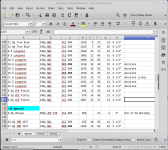I also use excell. One sheet per caliber, My rows are headed: Gun, Bullet, Weight, Case, Primer, Powder, Charge, COL. Then for Velocity Date: Rated, Ave, High, Low, ES, SD and PF and Energy. Then for Environmental, Altitude, Temp, Rh, Wind. Then for groups: Rounds, wind, range and MOA. The cells for things like PF and Energy contained formulas.
For the firearms I want to keep round counts on, I make one of 2 entries: Date with actual number of rounds, or annual with rounds in thousands. Firearm make, model, weight, optics is also listed within.
With all this data in excell, I then highlight the loads that I stick with for specific purposes. Those are the loads that are then entered into Shooter (Ballistic Calculator on web synced with phone app.) For instance, I have about 60 .308 loads through 4 different rifles. Some for competition, some for hunting. If I need to, or want to change a component or variable, all the trends are right there. I keep a "middle" of the road load in each caliber loaded in a small batch as a control for new barrels, loads, making sure the chrono is not acting up, etc. When I have a chance to shoot a rifle for an article, demo, etc., I have a known load I can shoot through it to easily compare accuracy, velocity, etc.
It is also easy to set a print area and then have empty cells to put in the chrono data when I go to the range.
While it is on my PC, it is also on a NAS with mirrored drives. My oldest entries were copied over from a notebook in 1992 that had 6 years of notes, so I have about 30 years of data from when I made my very first reload.



